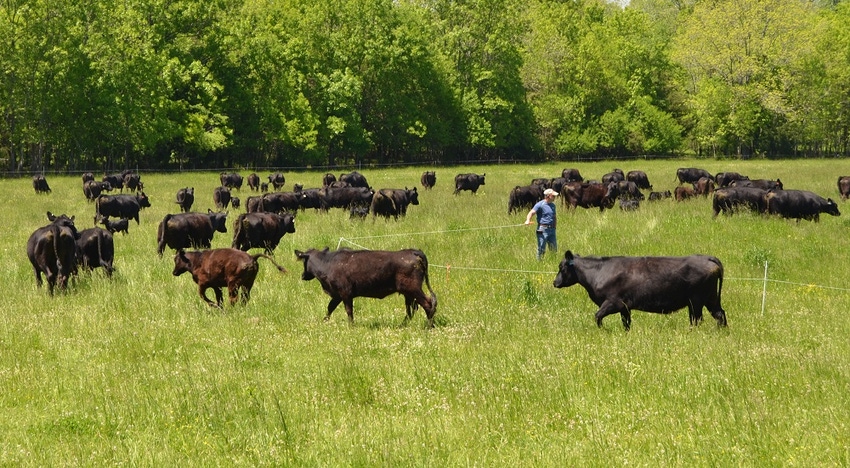Grazing with many animals in a smaller area and moving to fresh pasture more frequently builds soil health more quickly.

Graziers who have tried both ultra-high stock densities and a slower form of “rotational” grazing say increased stock density seems to build the land faster. The only two scientific experiments on the topic suggest this is true.
The first study was led by Texas A&M grazing ecologist Richard Teague, and Beef Producer had previously covered this topic. The gist of the research is this: Teague and colleagues measured conditions on three ranches fairly near each other in north-central Texas. They had similar soil types and topography, and native forage.
Same but different
The difference was they had been managed differently but each in the same way for 10 years or more. One used continuous heavy stocking. A second used light continuous stocking. The third was managed with what Teague called adaptive, multi-paddock grazing.
This means the ranch has multiple paddocks and was not managed the same way month after month. Instead, management was adapted to moisture and growing conditions, correct stocking rate, and cattle health and well-being. Although this ranch uses multiple paddocks, it does not practice particularly high-stock-density grazing.
Therefore, this study showed the improvement in land managed with adaptive, multi-paddock grazing compared with continuous grazing at either a heavy stocking or lighter stocking rate, as is sometimes the university recommendation for land improvement.

The study from Texas showed significant improvements in soil carbon, soil organic matter and cation exchange capacity because of adaptive, multi-paddock grazing versus either lightly or heavily stocked continuous grazing.
Benefits of managed grazing
In summary, Teague and colleagues showed significant improvements from the managed grazing:
less bare ground
more tall grass
fewer forbs
better fungi-to-bacteria ratio
higher soil organic matter
better cation exchange capacity
higher water-holding capacity
In Mississippi, a group of researchers also measured soil conditions on three ranches with relative proximity and similar soil types.
One of the ranches was continuously grazed (CG) for more than 10 years. One was grazed with lower-density slow rotations for more than 10 years. The third was managed for five years at the time of the research as an adaptive high-stock-density (AHSD) operation, with cattle moving one to five times a day, or sometimes more.
On the day the scientific team in Mississippi took samples in 2014, Allen Williams noted significant differences on the three sites.
“Immediate observations were that root structure and development, including root depth and mass, were significantly greater at the AHSD farm compared to slow rotation and CG farms. Root growth was observed all the way down to and past the 3-foot depth on the AHSD farm. On the other farms, root growth did not reach the 3-foot depth. In addition, there were noted differences in apparent soil life with earthworms immediately present in the soil of the AHSD farm. Earthworm populations were significantly lower at the slow rotation and CG farms.
Likewise, soil texture, aggregation and appearance was significantly better at the AHSD farm when compared to the slow rotation and CG farms.�”
Soil acidity and alkalinity
The soil pH for each farm was:
On the AHSD farm, soil pH was a constant 7.8 to 7.9 from 6 to 36 inches down.
On the slow-rotation farm, soil pH ranged from 5.8 in the top 12 inches to 7 at 36 inches.
On the CG farm, soil pH ranged from 5.6 in the top 12 inches to 4.9 at 36 inches.
These numbers help show the pH-moderating effect of soil organic matter, increased soil microbial life and likely higher levels of arbuscular mycorrhizal fungi, although that data wasn’t gathered.
The data also showed the amount of carbon stored in the soil was significantly greater at all depths and by all measurements, as was soil organic matter, as stock density increased.

In the study of three Mississippi farms, the total amount of carbon sequestered — and that includes total soil organic matter — was on the farm that used high-stock-density grazing for only five years, versus 10 years each for continuous and rotational grazing.
Adaptive = constant change
Allen Williams explains his adaptive grazing management and use of high stock densities on his Mississippi farm this way.
“I use a combination of three principles in our grazing strategy and teach these principles in our workshops,” Williams says. “I routinely alter practically everything. I go from lower stock densities to higher stock densities, and alter rotation patterns and time of the season. I employ various stocking densities in each area and so forth.
“I try very hard not to settle into a set system or rigid routine. That is where we make mistakes with grazing and soil health response.
“So, I may employ stock densities at times that are lower than 30,000 pounds per acre and then go with ultra-high stock densities. What I often tell folks when I show them slides illustrating various stock densities is that, ‘I do all of this some of the time, and none of it all of the time.’
“I want to keep nature confused and not allow stagnation.”
About the Author(s)
You May Also Like



